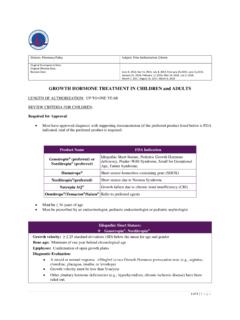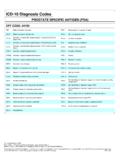Transcription of Endocrine disorders and children - WHO
1 1 children 's Health and the EnvironmentWHO Training Package for the Health SectorWorld Health disorders AND CHILDRENENDOCRINE disorders AND CHILDRENTRAINING FOR THE HEALTH SECTORTRAINING FOR THE HEALTH SECTOR[Date [Date ..Place Place .. ]Organizer]October 2011 <<NOTE TO USER: Please add details of the date, time, place and sponsorship of the meeting for which you are using this presentation in the space indicated.>> <<NOTE TO USER: This is a large set of slides from which the presenter should select the most relevant ones to use in a specific presentation. These slides cover many facets of the problem. Present only those slides that apply most directly to the local situation in the region.>> <<NOTE TO USER: This module presents several examples of risk factors that affect development, you can find more detailed information in other modules of the training package that deal with specific risk factors, such as lead, mercury, pesticides, persistent organic pollutants; or disease outcomes, such as developmental origins of disease, reproductive effects, neurodevelopmental effects, immune effects, respiratory effects, and others.
2 >>2 Endocrine disorders and childrenEndocrine disorders and childrenLEARNING OBJETIVES LEARNING OBJETIVES To understand the anatomy and functioning of the To understand the anatomy and functioning of the Endocrine system Endocrine system To describe Endocrine diseases that could be To describe Endocrine diseases that could be linked to the environmentlinked to the environment To present current knowledge of Endocrine To present current knowledge of Endocrine disrupting chemicals disrupting chemicals <<READ SLIDE>>3 Endocrine disorders and childrenEndocrine disorders and childrenOVERVIEWOVERVIEW Anatomy and physiology of the Endocrine system Anatomy and physiology of the Endocrine system Major Endocrine diseases in children , such as:Major Endocrine diseases in children , such as: Thyroidal dysfunctions Diabetes Obesity Precocious puberty Hypospadias and crytorchidism Endocrine cancers Endocrine disrupting chemicals Endocrine disrupting chemicals <<READ SLIDE>> <<NOTE TO USER: If your audience is already familiar with the Endocrine system, you may skip the introductory slides.
3 >>4 Endocrine disorders and childrenEndocrine disorders and childrenTHETHEENDOCRINE SYSTEMENDOCRINE SYSTEMM ajor glands that make up the human Endocrine system are:Major glands that make up the human Endocrine system are: Hypothalamus pituitary Thyroid Parathyroids Adrenals Pineal body Reproductive glands, which include the ovaries and testes The pancreas is also part of this hormoneThe pancreas is also part of this hormone --secreting system, secreting system, even though it is also associated with the digestive system even though it is also associated with the digestive system because it also produces and secretes digestive it also produces and secretes digestive the Endocrine glands are the body's main hormone producers, some non- Endocrine organs such as the brain, heart, lungs, kidneys, liver, thymus, pancreas, skin.
4 And placenta also produce and release disorders and childrenEndocrine disorders and childrenHORMONESHORMONES TheThewordwordhormonehormoneisisderivedd erivedfromfromthetheGreekGreek hormaohormao meaningmeaning I excite I excite ororarousearouse Hormones Hormones communicatecommunicatethisthiseffecteffe ctby by theirtheiruniqueuniquechemicalchemicalst ructuresstructuresrecognizedrecognizedby by specificspecificreceptorsreceptorsononth eirtheirtargettargetcellscells, by , by theirtheirpatternspatternsofofsecretions ecretionandandtheirtheirconcentrationsco ncentrationsin in thethegeneral general ororlocalizedlocalizedcirculationcircula tionC AlonzoC Alonzo<<READ SLIDE>>Images: C Alonzo. Used with disorders and childrenEndocrine disorders and childrenHORMONES HORMONES --FUNCTIONSFUNCTIONS ReproductionReproductionandandsexual sexual differentiationdifferentiation DevelopmentDevelopmentandandgrowthgrowth MaintenanceMaintenanceofofthetheinternal internalenvironmentenvironment RegulationRegulationofofmetabolismmetabo lismandandnutrientnutrientsupplysupplyWH O<<READ SLIDE>>Image.
5 WHO7 Endocrine disorders and childrenEndocrine disorders and childrenHORMONES HORMONES --FUNCTIONSFUNCTIONS The Endocrine system keeps our bodies in balance, maintaining homeostasis and guiding proper growth and development A single hormone may affect more than one of thesefunctions and each function may be controlled by severalhormonesWHOH ormone functions can be broadly grouped into several categories. For example, thyroid hormone isessential in development as well as many aspects of homeostasis and metabolism, whileglucocorticoids, such as cortisol, are important bothin growth and nutrient supply and are alsomodulators of immune function. The roles several hormones play in one function is exemplified by thecontrol of blood glucose that involves the pancreatic peptide insulin and its counter regulatoryhormone, glucagon, as well as cortisol, growth hormone and epinephrine.
6 Hormones act in concertand thus, an abnormality in a controlled variable, suchas blood glucose concentration may resultfrom defects in the control of any one of several : WHO8 Endocrine disorders and childrenEndocrine disorders and childrenCHALLENGES WITH THE Endocrine CHALLENGES WITH THE Endocrine SYSTEMSYSTEM Too much or too little of any hormone can be harmful to the Too much or too little of any hormone can be harmful to the body body If the pituitary gland produces too much growth hormone , a If the pituitary gland produces too much growth hormone , a child may grow excessively tall child may grow excessively tall If it produces too little, a child may be abnormally shortIf it produces too little, a child may be abnormally shortControlling the production of or replacing specific hormones can prevent many Endocrine disorders in children and disorders and childrenEndocrine disorders and childrenTHYROIDAL DYSFUNCTION AND THYROIDAL DYSFUNCTION AND ENVIRONMENTAL CHEMICALSENVIRONMENTAL CHEMICALST hyroidThyroidhormones are hormones are essentialessentialforfornormal normal brainbraindevelopmentdevelopmentduringdu ringa a criticalcriticalperiodperiodbeginningbeg inningin in uterouteroandandextendingextendingthroug hthroughthethefirstfirst2 2 yearsyearspostpartumpostpartumPOTENTIAL IMPACT ON BRAIN DEVELOPMENTT hyroid hormones are essential for brain development andadverse exposures during critical periodscould have an impact on brain : Porterfield S.
7 Thyroidal dysfunction and environmentalchemicals - potential impact on braindevelopment. Environ Health Perspect, 2000, 108:3,433-438 Certain polyhalogenated aromatic hydrocarbons such as polychlorinated biphenyls (PCBs) and dibenzo-p-dioxins (dioxins, 2,3,7, 8-tetrachlorodibenzo-p-dioxin) have been shown to have neurotoxiceffects and to alter thyroid function during critical periods of thyroid hormone -dependent brain development. This has led to the suggestion that some of the neurotoxic effects of these compounds could be mediated through the thyroid system. Thyroid hormones are essential for normal brain development during a critical period beginning in utero and extending through the first 2 years postpartum. They regulate neuronal proliferation, migration, and differentiation in discrete regions of the brain during definitive time periods.
8 Even transient disruption of this normal pattern can impair brain development. Thyroid hormones are necessary for normal cytoskeletal assembly and stability and the cytoskeletal system is essential for migration and neuronal outgrowth. In addition, they regulate development of cholinergic and dopaminergic systems serving the cerebral cortex and hippocampus. Animals perinatally exposed to certain environmental organohalogens such as many of the PCBs and dioxins have abnormal thyroid function and neurologic impairment. Although there are both species and congener variabilities, most reports show exposure results in thyroid enlargement and reduced serum T(4) levels with normal T(3) levels. Initial research concentrated on studying the direct actions of xenobiotics on the thyroid; however, some of these compounds bear a structural resemblance to the natural thyroid hormones and have high affinity with thyroid hormone -binding proteins such as transthyretin.
9 These compounds could act as agonists or antagonists for receptors of the thyroid/steroid/retinoic acid superfamily. These structurally similar organohalogenscould act at multiple points to alter thyroid hormone action. The similarity of the neurologic impairment seen in thyroid disorders to that seen following PCB or dioxin exposure suggests that one mechanism of neurotoxicity of these compounds could involve interaction with the thyroid disorders and childrenEndocrine disorders and childrenHYPERTHYROIDISMHYPERTHYROIDISM Hyperthyroidism is a condition in which the levels of Hyperthyroidism is a condition in which the levels of thyroid hormones in the blood are excessively high thyroid hormones in the blood are excessively high Symptoms may include:Symptoms may include.
10 Weight loss, nervousness, tremors, excessive sweating, weight loss, nervousness, tremors, excessive sweating, increased heart rate and blood pressure, protruding eyes, increased heart rate and blood pressure, protruding eyes, and a swelling in the neck from an enlarged thyroid and a swelling in the neck from an enlarged thyroid gland (goiter) gland (goiter) In children , the condition is usually caused by Graves' disease, an autoimmune disorder in which specific antibodies produced by the immune system stimulate the thyroid gland to become overactive. The disease may be controlled with medications or by removal or destruction of the thyroid gland through surgery or radiation disorders and childrenEndocrine disorders and childrenHYPOTHYROIDISMHYPOTHYROIDISM Hypothyroidism is a condition in which levels of thyroid Hypothyroidism is a condition in which levels of thyroid hormones in the blood are abnormally low.
















